HTTP GET Listener Configuration
HTTP GET Listener sends an HTTP GET request to a user-provided URL and returns the HTTP response of that query as a transaction.
Select the HTTP GET Listener or HTTP Connector from the Listener Type drop-down.
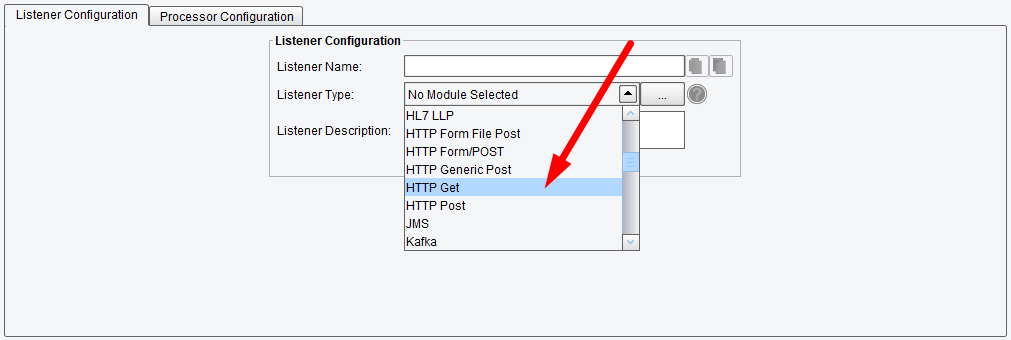
Listener (Adapter) Configuration Drop-Down List
This Listener has eight tabs: Basic, Advanced, Transaction Logging, Inactivity, Throttling, Authentication, Proxy, and Encoding.
Basic HTTP GET Listener Configuration Options
On the Basic tab, you can specify:
- Request Path – specifies the HTTP Path to request
- Polling Interval – how often the path is polling
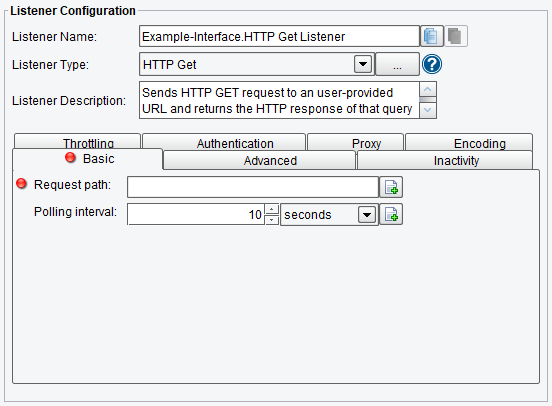
HTTP GET Listener Basic Configuration Options
Advanced HTTP GET Listener Configuration Options
On the Advanced tab, you can specify:
- Initialize on Trigger Only – if enabled, the Listener doesn’t start up until a trigger initializes it
- Allow Command-Line Invocation – if enabled, the Listener can be invoked using the CLI client application
- Restart on Listening Error – if enabled, the Listener will be restarted after an error occurs
- FIFO Queue Name – the FIFO option enables a “First In, First Out” queuing mechanism between Listeners and Transports. If a FIFO Queue Name is provided, it will be used as a key for a transaction queue. Transactions will be written to this queue before they reach a Transport. The transactions in this queue will be ordered according to when they were created by the Listener.
- FIFO Queue Delay – this is the interval between updates/checks against that queue. Providing a queue name guarantees that a given Transport sends transactions in the same order the Listener created them in.
- Trust Self-Signed Certs – enables a trust strategy that accepts self-signed server certificates as trusted
- Validate SSL Hostnames – SSL certificates include hostnames that they are valid for, under certain circumstances, you may want to disable this hostname validation
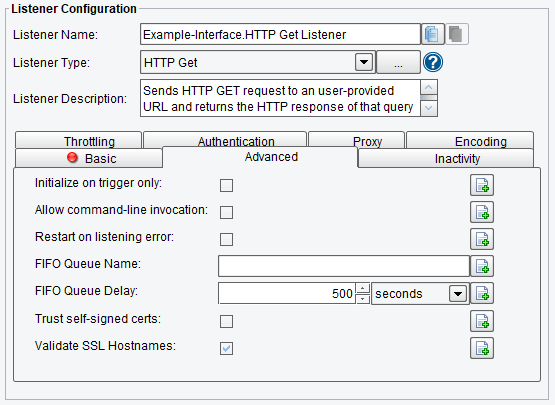
HTTP GET Listener Advanced Configuration Options
Inactivity HTTP GET Listener Configuration Options
On the Inactivity tab, you can specify:
- Enable Inactivity Monitor – check this box to enable inactivity monitoring. This will throw a non-transaction exception if the specified number of transactions haven’t been processed in the specified time interval.
- Min. Transactions to Expect – the minimum number of transactions to expect to be completed per Monitoring Interval
- Monitoring Interval – how often to check the specified number of transactions have been processed
- Times to Monitor – if set, monitoring will be done during the defined times of the day. To ignore, set start and end time equally.
- Days to Exclude from Monitoring – inactivity monitoring will not occur on the days specified
- Include Errors in Transaction Count – if checked, transactions that attempted to start but failed at the Listener stage will also be counted
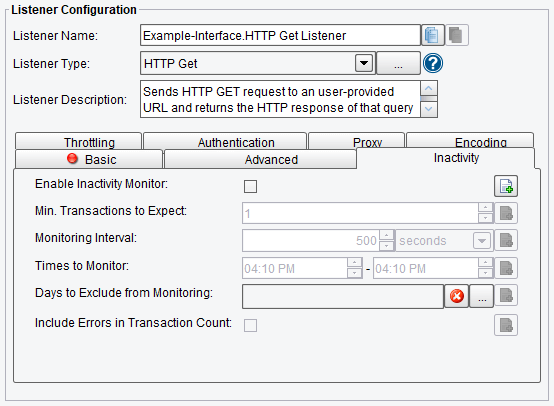
HTTP GET Listener Inactivity Configuration Options
Throttling HTTP GET Listener Configuration Options
On the Throttling tab, you can specify:
- Throttling Mode – the Throttling Mode to use for limiting the number of transactions or messages emitted by this Listener. “Timed” will limit transactions based on time intervals, while “Concurrent” will limit based on a concurrent number of transactions. “Concurrent” mode requires a Throttling Response Processor step later in the interface workflow to acknowledge completion.

HTTP GET Listener Throttling Mode
- Throttling Mechanism – the mechanism to use for throttling messages. “Blocking” prevents the Listener from continuing to process and emit messages altogether, while “Queued” pushes received messages into the Interface queue or a default, in-memory queue.
- Max Concurrent Messages – how many messages can be concurrently processed, either by time-based limits (“Allow X per Second”) or synchronous (“Allow X at any Time”)
- Timed Emission Interval – the interval for time-based limits (“Allow X per X Timed Emission Interval”)
- Synchronous Timeout Interval – the interval to wait for a synchronous response before failing
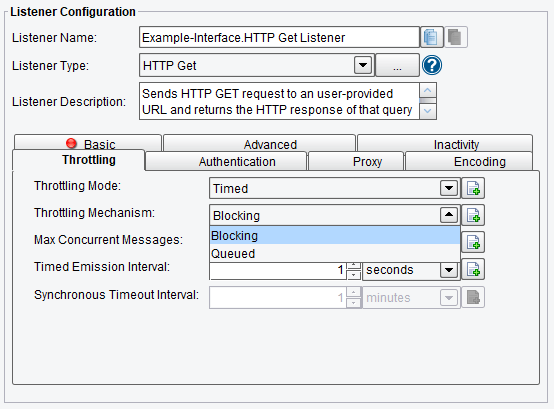
HTTP GET Listener Throttling Configuration Options
Authentication HTTP GET Listener Configuration Options
On the Authentication tab, you can specify Use Basic Authentication or not. If Basic Authentication is selected, you should specify a User Name and Password. Authentication Realm is optional.
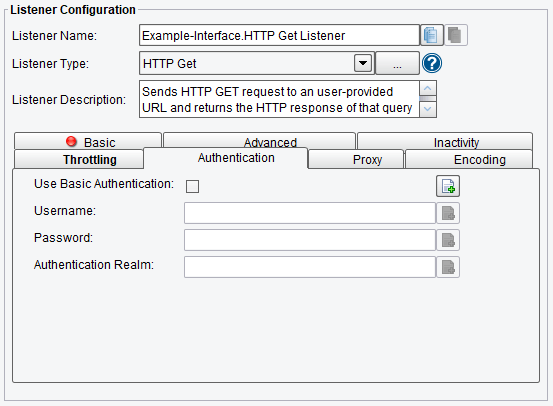
HTTP GET Listener Authentication Configuration Options
Proxy HTTP GET Listener Configuration Options
On the Proxy, you can specify Proxy Host, Proxy Port, Proxy User, and the Proxy Password, if you use it.
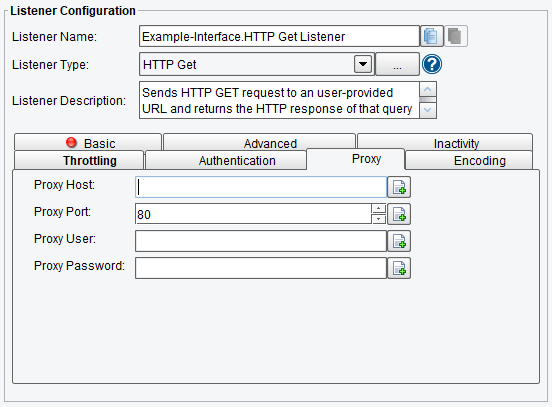
HTTP GET Listener Proxy Configuration Options
Encoding HTTP GET Listener Configuration Options
On the Encoding tab, you can specify:
- URL Param Encoding – the encoding to use for any parameters in the URL string
- Error Response Encoding – the encoding to use when serializing a response message in the event of an error with the request
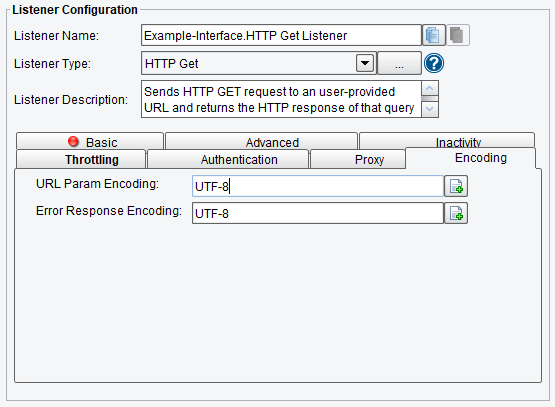
HTTP GET Listener Encoding Configuration Options
If you’re curious about the software features, free trial, or even a demo – we’re ready to answer any and all questions. Please call us at 813 864 8662 or click the button.
